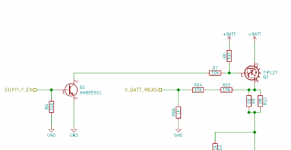Hello all,
as my HoverMower chassis is almost complete, I need to investigate in electronics. Because I'm not that familiar when it comes to FETs, I hope you can advise me.
So my Mower is equipped with a 10S2P Li-Ion battery ratet with 36V. When fully charged, it has up to 42V. The robot itself gets operated by a NVidia Jetson, which is similar to Raspberry PI when it comes to GPIO. So it provides 3.3V logic level. Beside that, a Arduino Nano gets used as perimeter receiver and for general power management operating with 5V.
Bernard send me a PCB named PowerBoard V1.01, which I want to use to monitor battery, toggle charging contacts on/off and to disconnect entire robot from battery before drawing it to death. This board I want to hook to Arduino Nano. One reason for this is, Jetson will take some time to boot up and I don't want to keep the button pressed that long.
Beside this requirement, I also want to switch some other components directly by Jetson Nano which are:
- LED headlights running at 15V (unknown current consumption as they're taken from HoverBoard and no data sheet is available)
- Lidar running at 5V, normally powered by USB, so it should not be more than 400mA
- Power Switch circuit of Motor driver. Normally a simple switch is used to turn Motor driver PCB on/off. I want to replace it with a FET so I can control it by Jetson. The switch closes the main circuit of board (like PowerBoard will do for entire robot). I measured full voltage through the switch, so the FET should also be able to handle 42V for a short moment
Can someone please help me to find a FET (or multiple different ones) which:
- switch 50V (or more) with only 3.3V gate voltage (high current flow as this is the main FET of robot)
- switch 50V/1 amp with only 3.3V gate voltage for a short period (max. 1 sec.) to turn motor driver on/off
- switch 15V ( or more) with a few 100mA with 3.3V gate voltage (LED headlights)
- switch 5V/400mA with 3.3V gate voltage (Lidar)
Maybe a single FET can cover all of these requirements which eases purchasing for me.
The following FETs I already owned but I'm not sure if they will work properly with 3.3V
- TIP120
- IRF9540N
- IRLIZ44N
I already checked the data sheets but to be onest, I'm simply lost in all these technical details.
BR Patrick
as my HoverMower chassis is almost complete, I need to investigate in electronics. Because I'm not that familiar when it comes to FETs, I hope you can advise me.
So my Mower is equipped with a 10S2P Li-Ion battery ratet with 36V. When fully charged, it has up to 42V. The robot itself gets operated by a NVidia Jetson, which is similar to Raspberry PI when it comes to GPIO. So it provides 3.3V logic level. Beside that, a Arduino Nano gets used as perimeter receiver and for general power management operating with 5V.
Bernard send me a PCB named PowerBoard V1.01, which I want to use to monitor battery, toggle charging contacts on/off and to disconnect entire robot from battery before drawing it to death. This board I want to hook to Arduino Nano. One reason for this is, Jetson will take some time to boot up and I don't want to keep the button pressed that long.
Beside this requirement, I also want to switch some other components directly by Jetson Nano which are:
- LED headlights running at 15V (unknown current consumption as they're taken from HoverBoard and no data sheet is available)
- Lidar running at 5V, normally powered by USB, so it should not be more than 400mA
- Power Switch circuit of Motor driver. Normally a simple switch is used to turn Motor driver PCB on/off. I want to replace it with a FET so I can control it by Jetson. The switch closes the main circuit of board (like PowerBoard will do for entire robot). I measured full voltage through the switch, so the FET should also be able to handle 42V for a short moment
Can someone please help me to find a FET (or multiple different ones) which:
- switch 50V (or more) with only 3.3V gate voltage (high current flow as this is the main FET of robot)
- switch 50V/1 amp with only 3.3V gate voltage for a short period (max. 1 sec.) to turn motor driver on/off
- switch 15V ( or more) with a few 100mA with 3.3V gate voltage (LED headlights)
- switch 5V/400mA with 3.3V gate voltage (Lidar)
Maybe a single FET can cover all of these requirements which eases purchasing for me.
The following FETs I already owned but I'm not sure if they will work properly with 3.3V
- TIP120
- IRF9540N
- IRLIZ44N
I already checked the data sheets but to be onest, I'm simply lost in all these technical details.
BR Patrick

